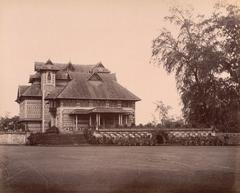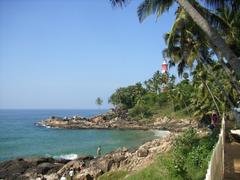Comprehensive Guide to Visiting Koyikkal Palace, Thiruvananthapuram, India
Date: 19/07/2024
Introduction
Nestled in the scenic town of Nedumangad in Thiruvananthapuram, Kerala, Koyikkal Palace stands as a testament to the region’s rich cultural and historical heritage. Constructed during the 16th century under the reign of Umayamma Rani of the Venad royal family, the palace is a splendid example of traditional Kerala architecture. It features unique architectural elements such as sloping roofs, wooden ceilings, and intricately carved wooden pillars. Today, Koyikkal Palace serves as a heritage museum, providing visitors with a unique glimpse into the past. The palace’s transformation into a museum in 1979 by the Kerala State Department of Archaeology has allowed it to house a vast collection of artifacts that reflect Kerala’s history and culture. This guide offers a comprehensive exploration of Koyikkal Palace’s history, architecture, visiting hours, and practical travel tips, ensuring an enriching experience for every visitor. (Kerala Tourism, Kerala State Department of Archaeology)
Table of Contents
- [Introduction](#introductionintroduction)
- [Origins and Construction](#origins-and-constructionorigins-and-construction)
- [Architectural Significance](#architectural-significancearchitectural-significance)
- [Historical Events and Royal Occupancy](#historical-events-and-royal-occupancyhistorical-events-and-royal-occupancy)
- [Transformation into a Heritage Museum](#transformation-into-a-heritage-museumtransformation-into-a-heritage-museum)
- [Notable Artifacts and Exhibits](#notable-artifacts-and-exhibitsnotable-artifacts-and-exhibits)
- [Preservation and Conservation Efforts](#preservation-and-conservation-effortspreservation-and-conservation-efforts)
- [Cultural and Educational Impact](#cultural-and-educational-impactcultural-and-educational-impact)
- [Visitor Information and Tips](#visitor-information-and-tipsvisitor-information-and-tips)
- [Location](#locationlocation)
- [Visiting Hours](#visiting-hoursvisiting-hours)
- [Entry Fee](#entry-feeentry-fee)
- [Guided Tours](#guided-toursguided-tours)
- [Photography](#photographyphotography)
- [Accessibility](#accessibilityaccessibility)
- [Best Time to Visit](#best-time-to-visitbest-time-to-visit)
- [Nearby Accommodations](#nearby-accommodationsnearby-accommodations)
- [Dining Options](#dining-optionsdining-options)
- [Nearby Attractions](#nearby-attractionsnearby-attractions)
- [FAQ Section](#faq-sectionfaq-section)
- [Conclusion](#conclusionconclusion)
- [References](#referencesreferences)
Origins and Construction
Koyikkal Palace, located in Nedumangad, Thiruvananthapuram, Kerala, India, is a significant historical monument that dates back to the 16th century. The palace was constructed during the reign of Umayamma Rani of the Venad royal family, who ruled between 1677 and 1684. The architectural style of the palace is a classic example of traditional Kerala architecture, featuring sloping roofs, wooden ceilings, and intricate carvings. Initially built as a residential complex for the royal family, the palace also served as a strategic location for administrative purposes.
Architectural Significance
The Koyikkal Palace is renowned for its unique architectural features that reflect the traditional Kerala style. The palace is a two-storied structure with a gabled roof, wooden balconies, and intricately carved wooden pillars. The use of wood in construction is a hallmark of Kerala architecture, designed to withstand the region’s humid climate. The palace also features a central courtyard, which was a common element in traditional Kerala homes, providing ventilation and natural light. The architectural design of Koyikkal Palace not only showcases the craftsmanship of the period but also reflects the cultural and historical context of the time.
Historical Events and Royal Occupancy
Koyikkal Palace has witnessed several significant historical events. During the reign of Umayamma Rani, the palace served as a center for administrative activities and a residence for the royal family. The palace also played a crucial role during the political turmoil of the 17th century, including the conflicts between the Venad kingdom and neighboring regions. The strategic location of the palace made it an important site for military and political activities. Over the centuries, the palace has seen various occupants, including members of the royal family and high-ranking officials.
Transformation into a Heritage Museum
In the late 20th century, the Koyikkal Palace underwent a significant transformation. Recognizing its historical and architectural value, the Kerala State Department of Archaeology took over the palace and converted it into a heritage museum. The museum was inaugurated in 1979 and houses a vast collection of artifacts that provide insights into the region’s history and culture. The exhibits include ancient coins, traditional musical instruments, household items, and other artifacts that reflect the lifestyle and heritage of Kerala. The transformation of Koyikkal Palace into a museum has helped preserve its historical significance and made it accessible to the public.
Notable Artifacts and Exhibits
The Koyikkal Palace Museum is home to several notable artifacts that offer a glimpse into the rich cultural heritage of Kerala. One of the most significant exhibits is the collection of ancient coins, which includes rare and valuable coins from different periods of Kerala’s history. The museum also features traditional musical instruments, such as the ‘Chenda’ and ‘Edakka,’ which are integral to Kerala’s cultural and religious practices. Additionally, the museum houses a variety of household items, including traditional utensils, furniture, and tools, providing insights into the daily life of the people during the palace’s heyday.
Preservation and Conservation Efforts
The preservation and conservation of Koyikkal Palace have been a priority for the Kerala State Department of Archaeology. Efforts have been made to maintain the structural integrity of the palace and protect its architectural features. Regular maintenance and restoration work are carried out to address issues such as wood decay, termite infestation, and weather-related damage. The conservation efforts also include measures to protect the artifacts and exhibits housed in the museum. These efforts ensure that the historical and cultural significance of Koyikkal Palace is preserved for future generations.
Cultural and Educational Impact
Koyikkal Palace serves as an important cultural and educational resource. The museum offers educational programs and guided tours that provide visitors with insights into the history, architecture, and cultural heritage of Kerala. The palace also hosts cultural events and exhibitions that showcase traditional art forms, music, and dance. These activities help promote awareness and appreciation of Kerala’s rich cultural heritage. The palace’s transformation into a museum has also contributed to the local economy by attracting tourists and providing employment opportunities.
Visitor Information and Tips
Location
Koyikkal Palace is located in Nedumangad, Thiruvananthapuram, Kerala, India.
Visiting Hours
The palace is open to visitors from 9:00 AM to 5:00 PM, except on Mondays and public holidays.
Entry Fee
A nominal entry fee is charged for visitors, with discounts available for students and senior citizens.
Guided Tours
Guided tours are available and highly recommended to gain a comprehensive understanding of the palace’s history and significance.
Photography
Photography is allowed in most areas of the palace, but it is advisable to check with the museum authorities for any restrictions.
Accessibility
The palace is accessible by road, and parking facilities are available for visitors.
Best Time to Visit
The best time to visit Koyikkal Palace is during the cooler months from November to February.
Nearby Accommodations
Visitors can find various accommodation options in Thiruvananthapuram, ranging from budget hotels to luxury resorts.
Dining Options
There are several local eateries and restaurants in Nedumangad and Thiruvananthapuram that offer traditional Kerala cuisine.
For more information, visitors can refer to the official website of the Kerala State Department of Archaeology.
Nearby Attractions
While visiting Koyikkal Palace, travelers can also explore other nearby attractions:
- Padmanabhapuram Palace: Located about 50 km from Koyikkal Palace, this palace is another splendid example of traditional Kerala architecture.
- Napier Museum: Situated in Thiruvananthapuram, this museum showcases a vast collection of historical artifacts and artworks.
- Kuthiramalika Palace Museum: Also in Thiruvananthapuram, this museum is known for its exquisite wooden carvings and royal artifacts.
- Ponmudi Hill Station: A picturesque hill station located about 60 km from Koyikkal Palace, offering scenic views and trekking opportunities.
FAQ Section
Q: What are the visiting hours for Koyikkal Palace? A: The palace is open from 9:00 AM to 5:00 PM, except on Mondays and public holidays.
Q: Are there guided tours available at Koyikkal Palace? A: Yes, guided tours are available and highly recommended.
Q: What is the entry fee for Koyikkal Palace? A: A nominal entry fee is charged, with discounts for students and senior citizens.
Q: Can I take photographs inside Koyikkal Palace? A: Photography is allowed in most areas, but it’s best to check with the museum authorities for any restrictions.
Q: What are the best nearby attractions to visit along with Koyikkal Palace? A: Nearby attractions include Padmanabhapuram Palace, Napier Museum, Kuthiramalika Palace Museum, and Ponmudi Hill Station.
Conclusion
Koyikkal Palace is not just a historical monument but a vibrant cultural hub that offers a unique insight into Kerala’s rich heritage. Whether you’re a history buff, an architecture enthusiast, or a curious traveler, a visit to Koyikkal Palace is sure to be a memorable experience. Plan your visit today, explore the fascinating exhibits, and immerse yourself in the history and culture of Kerala. Don’t forget to check out other related posts and follow us on social media for more updates. By preserving its historical and cultural heritage, Koyikkal Palace continues to be a significant landmark in Kerala, offering visitors a unique glimpse into the region’s past.





